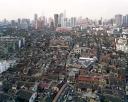China has become the land of 1,000 identical cities, a senior government official has warned in an outspoken attack on the country’s headlong rush towards modernity.
Qiu Baoxing, the vice-minister of construction, said the damage to the country’s heritage was similar to that wrought during the cultural revolution.
In the early stages of that 1966-76 period, Red Guards ransacked temples and burned ancient scripts in the name of revolutionary politics.
Today, the damage is more likely to be done by urban developers in the name of economic progress.
Historical sites and cultural relics have been devastated by “renovation” projects, Mr Qiu was quoted as saying by the China Daily.
In an unusually fierce criticism of the architectural landscape of modern China, the vice-minister said that too many local governments were guilty of a “blind pursuit of the large, the new and the exotic”.
“This is leading to a poor sight. Many cities have a similar construction style. It is like a thousand cities having the same appearance,” he said.
He said such “senseless actions” were the fault of local officials, who were “totally unaware of the value of cultural heritage”.
His comments underscore concerns that China, one of the world’s oldest civilisations, is paying too high a price for its economic expansion.
Throughout the country, old buildings are making way for residential towers, office blocks and motorways.
Developers have torn down tens of thousands of traditional courtyard homes in Beijing, countless colonial-era neighbourhoods in Shanghai and swaths of other historical cities. In their place are wide streets, concrete squares and huge right-angled buildings — often with the same small white tiles and blue-tinted windows.
In Lhasa, such is the threat to traditional Tibetan architecture that the World Heritage Committee called on China to reconsider its demolition plans a few years ago.
Even many so-called “heritage” schemes have a dubious value. The popular Xintiandi area of Shanghai was flattened and rebuilt in an old style — plus Starbucks, bars and boutiques. Such is its commercial success that many other municipalities consider it a model for “cultural renovation”.
Tong Mingkang, deputy director of the state administration of cultural heritage, said this faking of history made the country poorer. “It is like tearing up an invaluable painting and replacing it with a cheap print,” he told the state media.
Jonathan Watts
Guardian Unlimited

Δεν υπάρχουν σχόλια:
Δημοσίευση σχολίου